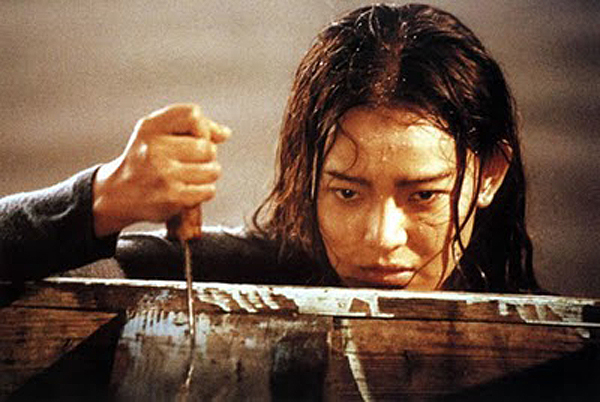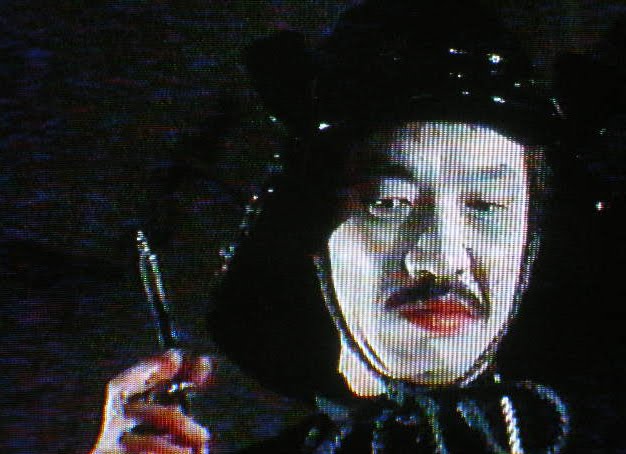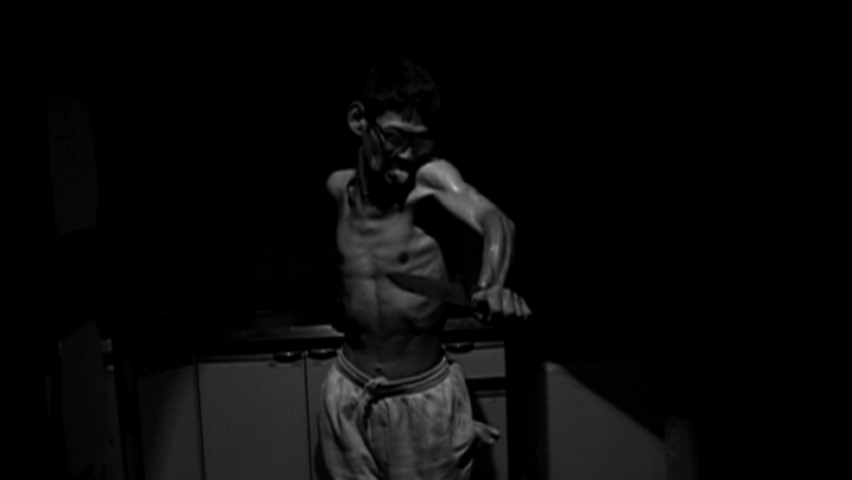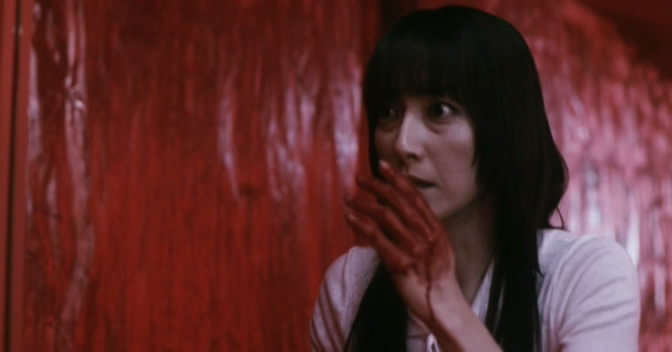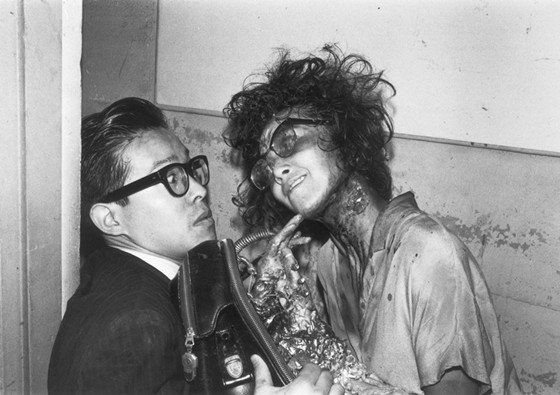9. Executive Koala (Minoru Kawasaki, 2005, Japan)
This particular film is another preposterous story from a filmmaker that excels in that field, since his filmography includes titles like “The Calamari Wrestler” and “Kabuto-O Beetle”.
Keichi Tamura is an executive in a food company that specializes in pickles. He is a model employee; however, he has three issues. He is tormented by memory loss and from the mysterious disappearance of his wife and lastly, he is literally a koala. Nevertheless, this last fact does not seem to alienate anyone in a company, whose president is actually a rabbit.
Tamura’s life seems to proceed calmly until another disappearance, this time his girlfriend, turns the attention of the police toward him, particularly when the body of the girl is found stabbed to death. His forgotten past gradually surfaces, and a general suspicion arises that maybe Tamura is not the kindhearted koala everyone knows and loves.
Minoru Kawasaki once said that he wants to stay silly for his rest of his life and he wholeheartedly incorporates his philosophy in here. Nevertheless, “Executive Koala” has it all: comedy, social meditations, thriller, martial arts, mystery, music, and mental illness.
This is trash cinema at its best; a film that is extreme due to its nonsensicality.
10. The Isle (Kim Ki Duk, 2000, S. Korea)
Hee Jin is a young woman who rents floating platforms to anglers in a lake. Additionally, she provides them with prostitutes if they ask and occasionally prostitutes herself. Her life is miserable, though calm, until Hyun Shik, an unusual renter arrives, who seems to have issues with the police. Nevertheless, the two of them strike a peculiar love affair, tortured by egoism, fatal accidents and a ferociousness that leads to extreme measures by both of them.
Kim Ki Duk presents an ode to antithesis. The splendid scenery at the lake in contrast to the mundane life of the anglers; the wealth of the entrepreneur who finds the body in contrast to the couple’s poorness; the anger of both the protagonists in contrast to their unfathomable love; the graphic scenes of self injury in contrast to the poetic, calm scenery.
His direction is characterized by utmost simplicity, since he has removed any kind of explanatory scenes. His protagonists’ motives are simple in that they are animalistic. They feel lust, jealousy, pain and fear and react accordingly.
The fact is that Pieta and Moebius are further gruesome altogether. However, “The Isle” incorporates the two foremost grisly scenes in Kim’s filmography, the suicide attempts with hooks. Furthermore, it entails violent scenes with animals that Kim stated were real.
At its screening at the Sundance Film Festival, a large share of the audience walked out, while at the Venice Film Festival a few even fainted.
11. In the Realm of Senses (Nagisa Oshima, 1976, Japan)
“In the Realm of Senses” is one of the foremost controversial movies in the history of cinema, with critics and fans still debating if it is of high artistic value or just pornography.
Nagisa Oshima based the film on the true story of Sada Abe, a woman who in 1936 erotically asphyxiated her lover and subsequently proceeded to cut off his penis and testicles and carry them in her kimono. The movie describes the relationship between Sada Abe and Kichizo Ishida, a hotel owner, through a plethora of erotically perverted scenes, up to its tragic conclusion. Furthermore, solely excluding the mutilations scene, the rest of the erotic scenes incorporated actual sex, including fellatio and an orgy with geisha using sex aids.
However, beyond its evident promiscuity, Oshima managed to present, inside a claustrophobic setting, an erotic affair of intense paroxysm, a manifestation of love that surpassed the borderline of the extreme.
Oshima was forced to transfer the shooting to France in order to complete his film, subsequently baptizing it a French-Japanese production to be able to release it. Nevertheless, after its first screenings, it was banned in the US, Canada, Germany, Japan and other countries, eventually having to reach the ’90s in order to be screened in its full duration, which lasts 90 minutes. It is still forbidden in Ireland.
12. Guinea Pig: Flower of Flesh and Blood (Hidoshi Hino, 1985, Japan)
This is the second and foremost vicious part of a series of seven splatter video movies, whose violent scenes were realistic to the point that the producers were forced to prove to the authorities that none of the actors were literally traumatized or murdered.
A murderer, dressed as a samurai, kidnaps a girl and subsequently proceeds to torture and mutilate her, in order to create a flower of flesh and blood. Hidoshi Hino directs a collage of beating, torture and other sadistic exercises, instead of an actual movie.
The particular segment gained notoriety for two reasons. First, Charlie Sheen, after watching the film, believed it was a snuff film and delivered it to the FBI to investigate it. Second, upon the research in serial killer Tsutomu Miyazaki’s house, the police discovered a video tape of the movie that resulted in the public’s belief that he was inspired by it. However, it was later disclosed that it was, in fact, the sixth segment of the series.
Unavoidably, the Japanese authorities banned “Flower of Flesh and Blood” and no one could find a copy until its re-release by a German company in 2002, while a full edition was released in the US in 2005.
13. Late Bloomer (Go Shibata, 2004, Japan)
Sumida is a handicapped man in a wheelchair, a fact not stopping him from being a party animal, desiring to drink beer, hang out with friends, attend concerts and meet girls. However, when his feelings toward a recent occasional retainer are not reciprocated, Sumida, frantic by desire and frustration, proceeds on a killing spree.
Go Shibata presents a film concerning inability that keeps its distance from the common triumph stories typically shot regarding this topic. Instead, “Late Bloomer” focuses on the violent ascending of the protagonist, to a world where anybody is an enemy worth killing.
Additionally, the actual actor, Masayiko Sumida, suffers from the same illness as the homonymous character, thus resulting in a terrifyingly realistic film. Furthermore, the aesthetics of the movie, including the lack of color, the sound and the editing, are similar to “Tetsuo”, a factor that adds to its extremity.
Shibata took five years to complete the film and even more to clear it for distribution in Japan. However, festivals around the world screened it, netting it significant acclaim.
14. Strange Circus (Sion Sono, 2005, Japan)
“Strange Circus” is probably Sion Sono’s foremost extreme film, a fact that, concerning this particular director, definitely says a lot. Rape, pedophilia, incest, transexuality and a plethora of other notions that each on its own might characterize a film as disturbing, are all included in this grotesque masterpiece.
A school principal places his daughter inside a cello case he had modified for her to be able to watch him having sex with her mother. The latter eventually realizes that fact; however, she is not able to stop her husband from continuing his practice. Furthermore, over time, he begins changing the places of the two women, an effort that leads to the daughter ultimately starting to savor the sex with her father and her mother’s fits of jealousy towards her, resulting in violence.
In the future, the daughter has become a successful author, mostly by describing her childhood experiences. Nevertheless, because she is handicapped and has to sit in a wheelchair, her publishers hire an assistant for her, who eventually turns the entire story upside down.
Sono drowns his film in blood-red color, presenting a plethora of utmost sick characters, each one perverse in his own way. Through surrealism, he weaves an intricate story that lurks among the violence and extremity, with heaps of turnarounds and an utterly unexpected finale.
15. Versus (Ryuhei Kitamura, 2000, Japan)
Two convicts manage to escape prison with the assistance of a few Yakuza that they later meet in a forest. However, the latter double crosses them and a dispute occurs regarding a kidnapped girl that leads to a skirmish between the two teams.
Eventually it is disclosed that the bucolic environment is the Forest of Resurrection, the 444th of the 666 gates to hell, where every person dying in its grounds is resurrected as a zombie. Additionally, a character by the name of The Man appears baring supernatural powers and the desire to capture the two heroes.
Ryuhei Kitamura directs a film where action is frantic and unrelenting, blending samurai, zombies and Yakuza elements, all of which are connected through extreme gore. “Versus” is evidently low budget; however, the choreography of the swordplay, the martial arts and the gun battles are intricate and the expected bloodbath seems to appear in every scene. Also of note is the soundtrack, which, similar to the movie, incorporates a plethora of styles.
“Versus” has acquired a rather large audience all over the world and a definite cult status.
16. Pieta (Kim Ki Duk, 2012, South Korea)
This specific production is Kim’s utmost celebrated one, netting a plethora of awards from festivals around the world, including the Golden Lion at the Venice Film Festival, and the Best Film in Blue Dragon Awards.
The script unfolds in Cheonggyecheon, a poor neighborhood in the centre of Seoul, which is full of little technical shops and is inhabited chiefly by petit bourgeois owners and workers. In this area lives Kang Do, a violent collector working for a local loan shark. He forces those who owe and cannot handle the payments to self traumatize (or hurts them himself) in order for him to receive the compensation from their insurance company.
One day while working, he realizes that a middle-aged woman is permanently following him, leaving him meals in his house and even helping him with his victims. Eventually he discovers that the woman is actually his long lost mother, who abandoned him when he was little, an action that shaped him as a person. Kang Do initially reacts violently towards her; however, gradually he becomes accustomed to Mi Son’s presence, a tactic that results in a number of sick occurrences.
Kim Ki Duk’s utmost commercial work is however, as onerous as the rest of his filmography, a fact stressed by the usage of digital camera that makes the violent scenes seem even more realistic, virtually documentary-like. The standard message residing in the majority of Kim’s works also appears here: the world we live in is ugly and evil and people are either monsters or victims.
Lee Jung Jin as Kang Do and Jo Min Su as Mi Son both astonish in their parts, sublimely presenting an onerous, Oedipal relationship.
Kim’s purpose was to shock the audience, a tactic that paid off since “Pieta” drew strong reactions from fans and critics all over the world, due to its themes and graphic depiction of violence.
17. Tetsuo (Shinya Tsukamoto, 1989, Japan)
A car accident victim sticks a metallic tube in his thigh, an impulse after which his body is taken over by a metal. Something similar also occurs with the accident’s perpetrator and the action begins. Women raping with metallic phalli, sex with penises in the form of electric drills resulting in murder, hunting in dark corridors, bodily fluids, and a final confrontation between two beings that are more machines than humans are only a few of the grotesque spectacles in “Tetsuo”.
Shinya Tsukamoto used a 16mm camera and shot a black and white film that looks like a nightmarish video clip, an outcome intensified by the extreme noise music and the restless movement of the camera. The message concerning technophobia and the loss of humanity for the sake of technology is evident. However, even more apparent is the fact that the director aimed to shock through extreme violence, a purpose he completely fulfilled.
“Tetsuo” is clearly a low budget film; nevertheless, it established Tsukamoto as an international cult filmmaker and resulted in two sequels.

